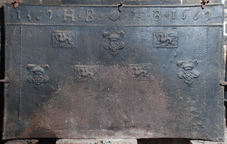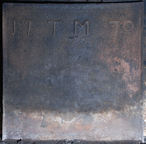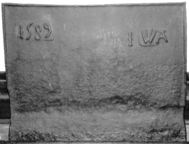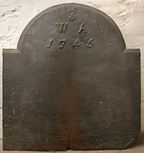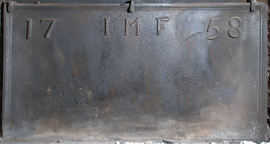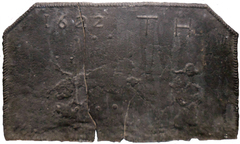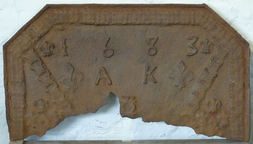-
91
Description: Rectangular; twisted rope edging (top and sides); narrow top panel and two narrow side panels, each separated by twisted rope; top panel with symmetrical inscription line begun and ended with a stamp formed of four spots in square, the same stamps separating the date, each of the initials and a central rose stamp, the date being repeated at each end; plain side panels; central panel comprising three shields bearing a rose and crown, one on the top line between two rectangles, each bearing a griffin passant, and two shields on the ends of the lower line with two rectangles with griffins between, the bottom half of the plate is plain.
Notes: The shield and griffin stamps appear on two firebacks at Hastings Museum, in each of which the shields are inverted.
Inscription: 1569 HB AB 1569
- Decoration tags:
- rectangular (shape)
- rope (edging)
- simple stamps
- carved stamps
- individual letters
- individual numbers
- heraldic
- text
- animals
- plants
Manufactured: in 1569 in the Weald area of England.
Current location: in private hands, Hadlow Down, East Sussex, England.
- Attached to series:
- Griffin series
- Date & initials firebacks
-
101
Description: Rectangular; cavetto moulded edging; date aplit by intitials placed centrally at top.
Inscription: 17 TM 70
- Decoration tags:
- rectangular (shape)
- cavetto (edging)
- individual letters
- individual numbers
- text
Manufactured: in 1770 possibly in the Weald area of England.
Current location: in private hands, Hartfield, East Sussex, England.
- Attached to series:
- Date & initials firebacks
-
116
Description: Rectangular; twisted rope edging (top and sides); top left, date carved on block; top right, individual letter 'I' followed by 'WA' carved on block.
Notes: The same date stamp appears on a group of multi-facetted, arched firebacks bearing the crowned Tudor arms within a Garter. Formerly part of the Ade Collection (from Grove Hill, Hellingly, Sussex).
Inscription: 1589 I WA
- Decoration tags:
- rectangular (shape)
- rope (edging)
- carved stamps
- date stamp
- text
Manufactured: in 1589 in the Weald area of England.
Current location: Hastings Museum and Art Gallery, John's Place, Bohemia Road, Hastings, East Sussex, England.
Museum number: HASMG: 1952.51.42 (part of the Hastings Museum museum group)
- Attached to series:
- Date & initials firebacks
- 1589 series
-
118
Description: Rectangular with triangular pediment; stepped fillet and ogee moulded edge; initials in rectangular panel (F reversed); date in portico.
Notes: The triangular top is a separate element, in this instance impressed before the lower panel. A variant at the Victoria and Albert Museum (no. 771) has the letters positioned slightly differently. A version of this fireback, with a rope-edged panel in the lower part, and medallion stamps, can also be seen at Hastings. Formerly part of the Ade Collection (from Grove Hill, Hellingly, Sussex).
Inscription: 1586 F M
- Decoration tags:
- triangular arched (shape)
- stepped fillet and ogee (edging)
- individual letters
- date stamp
- text
Manufactured: in 1586 in the Weald area of England.
Current location: Hastings Museum and Art Gallery, John's Place, Bohemia Road, Hastings, East Sussex, England.
Museum number: HASMG: 1952.51.58 (part of the Hastings Museum museum group)
Citation: Lloyd, N., 1925, 'Domestic Ironwork I', Architectural Review, 58, pp. 58-67.
- Attached to series:
- 1586 series
- Date & initials firebacks
-
190
Description: Arched rectangle; bevelled edge to arch and top of shoulders; initials at centre top of arch, in triangle 'S' at top; date below initials.
Notes: Possibly the work of David Robertson (1716-93), the King's Smith, whose iron grates are commonly to be found in houses designed by the prominent Scottish architects, Robert, John and James Adam, of whom he was a kinsman; the form of the plate is typical of grate-backs Robertson made in a variety of sizes, notably at Dumfries House, Ayrshire, although the lack of evidence of fixings suggest that this may have been made to be free-standing. Until 1756/7 Robertson had his forge in a tenement in Niddery's Wynd, Edinburgh, between High Street and Cow Gate, next door to John Adam's premises, although it is not known if he had a foundry there.
Inscription: S / W A / 1745
- Decoration tags:
- rectangular with round arch (shape)
- individual letters
- individual numbers
- text
Manufactured: in 1745 possibly in the Edinburgh area of Scotland.
Current location: Hill Top, Sawrey, Hawkshead, Hawkshead, Cumbria, England.
Museum number: 641831 (part of the National Trust museum group)
- Attached to series:
- Date & initials firebacks
-
902
Description: Rectangular with ogee moulded edging (top and sides); symmetrically spaced along the top, initials, IMF, between split date in well-defined characters.
Notes: The initials are believed to be of John Meers Fagg, who owned Blackford Farm, Herstmonceux, at that date. Fagg purchased three firebacks from Heathfield Furnace, Sussex, in September 1758, costing £4 10s. 6d. They were cast by Thomas Cavie, who was paid a shilling a piece (East Sussex Record Office, Brighton, SAS-RF/15/3/35, f.22). At least one other fireback is known with some of the same character set.
Inscription: 17 IMF 58
- Decoration tags:
- rectangular (shape)
- cyma reversa/ogee (edging)
- carved stamps
- individual letters
- individual numbers
- text
Manufactured: in 1758 at Heathfield Furnace in the Weald area of England.
Current location: in private hands, Herstmonceux, East Sussex, England.
- Attached to series:
- Date & initials firebacks
- 1750s Heathfield series
-
1038
Description: Canted rectangular shape; edging formed of lengths of cross-cut dowel (top and sides); inscription across upper centre probably formed of thumb prints; the last digit of the date may be an incomplete 5 rotated left.
Notes: A crudely executed fireback; the cross-cut dowel used for the edging has not been noted on any other fireback.
Inscription: 16 wo 15[?]
- Decoration tags:
- rectangular with canted top corners (shape)
- cross-cut dowel (edging)
- simple stamps
- individual letters
- individual numbers
- text
Manufactured: in the early-17th century in the Weald area of England.
Current location: Herstmonceux Castle, Herstmonceux, East Sussex, England.
- Attached to series:
- Date & initials firebacks
-
1176
Description: Canted rectangular shape; twisted rope edging (top and sides); top left, date 1622; top right, initials T H.
Notes: The surface excrescences on the lower half of the fireback are likely to have resulted from the displacement of the casting sand by the pouring of the iron. Formerly at Marden Hill House, Tewin, Hertfordshire. There is no basis for the suggestion by Hertford Museum that this fireback might have been cast by a Thomas Hogge.
Inscription: 1622 T H
- Decoration tags:
- rectangular with canted top corners (shape)
- rope (edging)
- simple stamps
- carved stamps
- individual letters
- individual numbers
- text
Manufactured: in 1622 possibly in the Weald area of England.
Current location: Hertford Museum, 18 Bull Plain, Hertford, Hertfordshire, England.
Museum number: HETFM2893.1 (part of the Hertford Museum museum group)
- Attached to series:
- Date & initials firebacks
-
1271
Description: Rectangular shape; twisted rope edging (top and sides only); central initials, WS, in different character sets, between split date, also in different numeral sets, with a rectangular floral patera repeated at each end; below, and at a slight incline to the right, a horizontal twisted rope dividing the plate. The '5' of the date has been stamped in reverse.
Notes: A boldly cast fireback with disparate character styles. Probably acquired for the castle in the early-20th century during its refurbishment for Edward Hudson by Edwin Lutyens.
Inscription: 1 6 W S 7 5 [5 reversed]
- Decoration tags:
- rectangular (shape)
- rope (edging)
- simple stamps
- carved stamps
- individual letters
- individual numbers
- text
- plants
Manufactured: in 1675 in England.
Current location: Lindisfarne Castle, Holy Island, Northumberland, England.
Museum number: 511616 (part of the National Trust museum group)
- Attached to series:
- Date & initials firebacks
- Miscellaneous stamp firebacks
-
832
Description: Canted rectangular; astragal edging (top and sides), inside of which are repeated panels carved with overlapping fleurs-de-lys; upper centre, date evenly spaced in individual numerals; below date, initials evenly spaced in individual letters; at each end of date, single small fleur-de-lys stamp; at each end of initials, large hollow fleur-de-lys; diagonally from each lower corner of canting, line of six squared cross stamps; in bottom corners, triad of small fleur-de-lys stamps each enclosing a large fleur below; bottom centre, woodblock stamp.
Notes: The repeated fleur panels are likely to have derived from furniture. Varied use of the same stamps are on other firebacks, including one dated 1667 at Upper End Farm, Hope Mansell, Herefordshire.
Inscription: 1683 / AK
- Decoration tags:
- rectangular with canted top corners (shape)
- astragal (edging)
- carved stamps
- individual letters
- individual numbers
- heraldic
- text
Manufactured: in 1683 in the Forest of Dean area of England.
Current location: not known.
